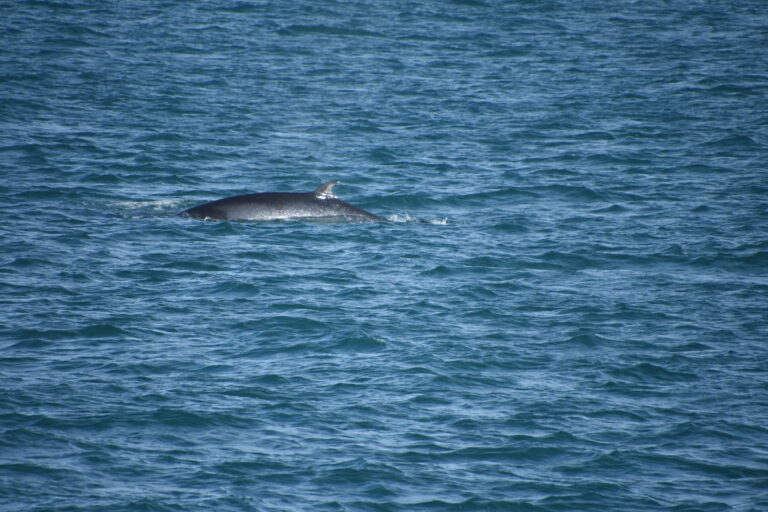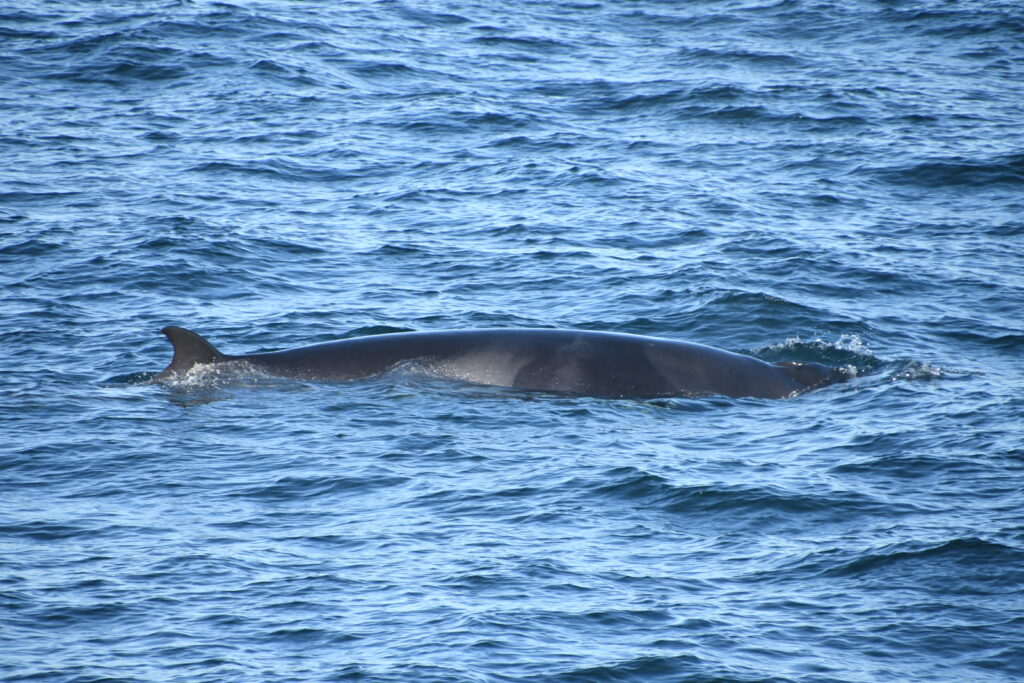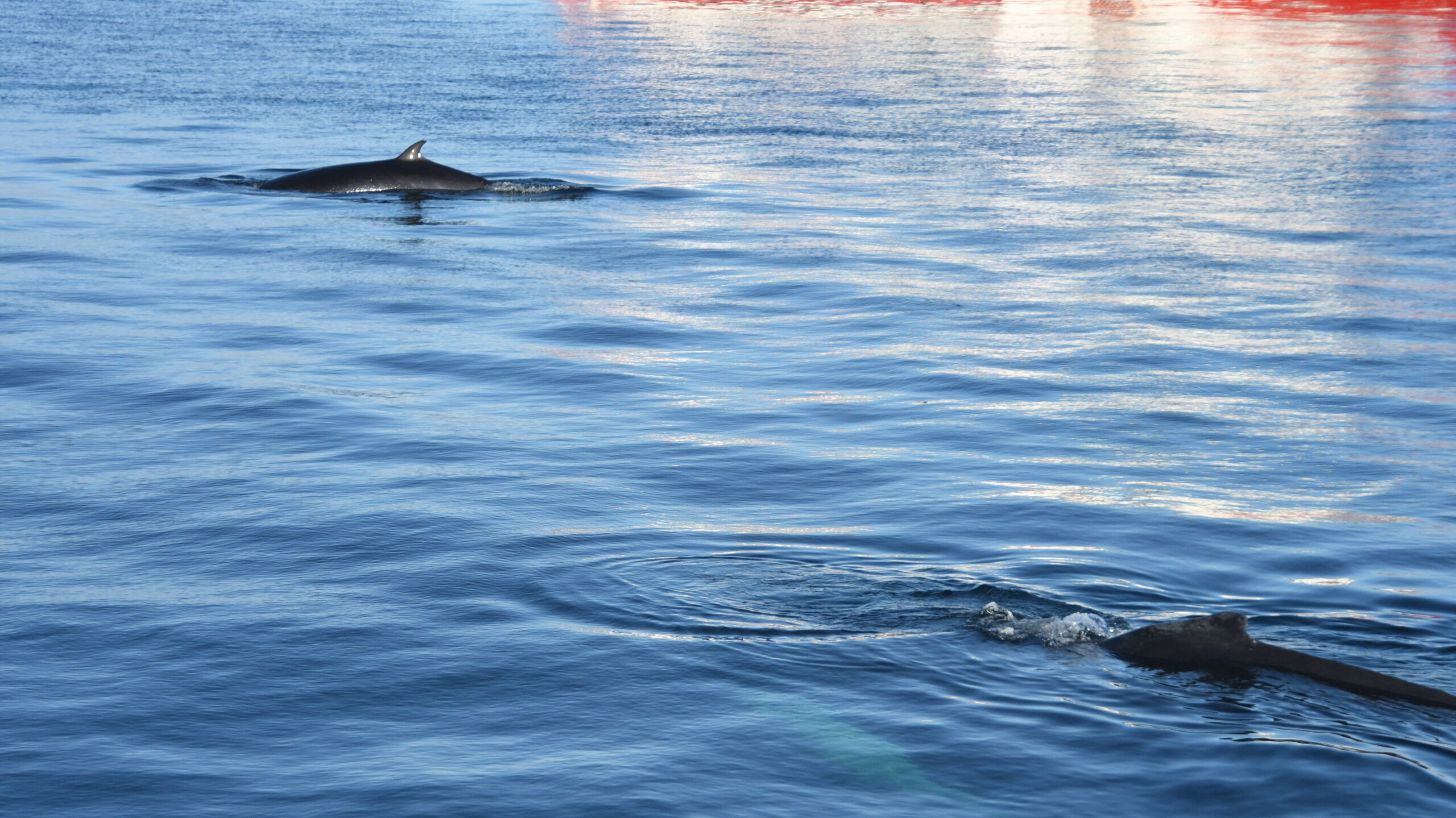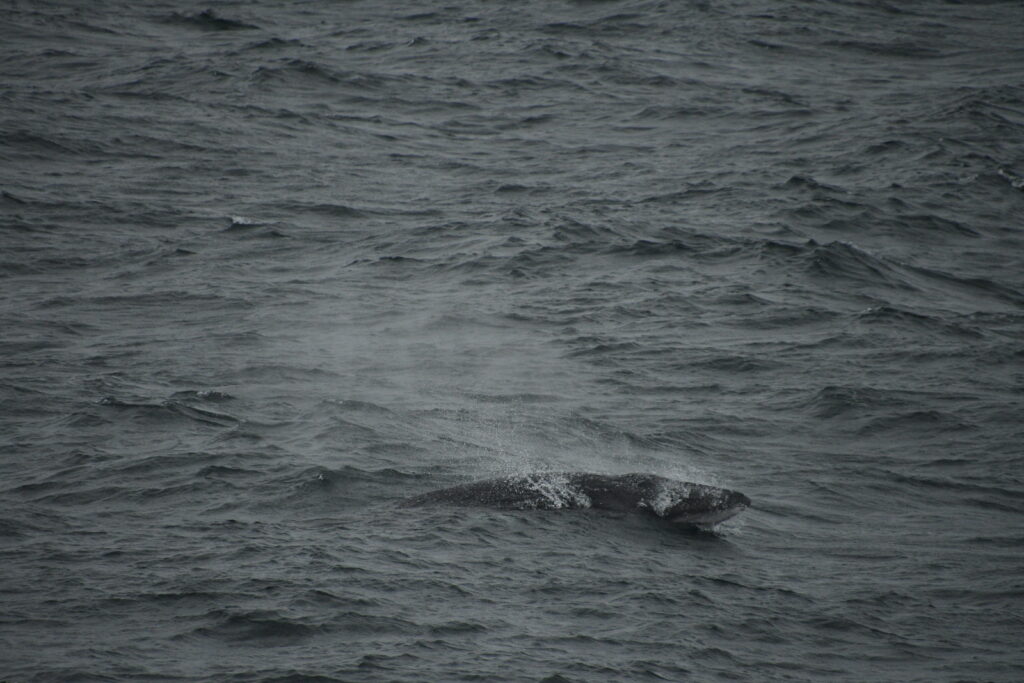Minke Whale: The Under-Appreciated Whale

In our previous blog, we talked about the humpback whale – the largest whale commonly seen here in Iceland! But its lesser-known relative, the common minke whale, is often overlooked.

They are one of the smallest baleen whales, with females growing up to 11 m and males up to 9 m. Although they are small, they still weigh up to 9-10 tonnes! Baleen whales are those that don’t have teeth but have these really cool baleen plates instead. Their upper jaw is filled with 230-360 pairs of them! They are also the smallest rorqual whale – rorquals are pleats on the underside of their lower jaw, and they have 50-70 of them. These allow their mouths to expand really big!
A key feature for identifying the common minke whale is the white band located in the middle of their pectoral fins! Some research suggests that they use this when feeding, reflecting light off it to confuse the fish. About two-thirds down their back is the sickle-shaped dorsal fin! Their colouring can range from black to dark grey or brown, and they have a pale chevron behind their head.


Minke whales, taken on-board by Rebecca Roberts
The scientific name for the common minke whale is Balaenoptera acutorostrata, which translates to “winged whale” and “sharp snout,” due to their really pointed rostrum! However, they received the name ‘minke’ after the Norwegian whaling spotter – Meincke – who supposedly mistook a minke whale for a blue whale! Throughout whaling history, minke whales were often overlooked by whalers as they were too small and too fast to be hunted. That was until other species became depleted, and minke whales were targeted. Unfortunately, minke whales are still hunted in Iceland, Japan, and Norway. However, the good news is that they are still the most abundant baleen whale, with an estimated ~13,000 individuals in Iceland during the summer.

Minke Whale: three subspecies
There are three subspecies of the common minke whale – the North Atlantic, the North Pacific, and the dwarf minke, and there is another species – the Antarctic minke whale! The dwarf minke is much smaller, as given away by its name, growing only to 8 m and weighing around 6 tonnes. Compared to the common minke, which has very white baleen plates, dwarf minke whales have a thin black border on them! The white band on their pectoral fins also differs by extending to their shoulder.
The Antarctic minke whale’s pectoral fins don’t actually have the white bands, and they have fewer baleen plates (200-300 pairs), which have asymmetrical colouring. They also differ from the common minke by having only 22-38 rorqual pleats. Studies have shown that there is hybridization between Antarctic and common minkes in the northeast Atlantic!

Compared to humpback whales, which can live up to 90 years old, minke whales can only live up to 50. They are usually very solitary but can also be seen in small groups of 2 or 3 in close proximity. In feeding areas, there have been sightings of 400 minke whales loosely grouped together! Similarly to other baleen whales, minke whales feed by side-lunge feeding, consuming crustaceans, plankton, and small schooling fish. However, if their prey of choice isn’t around, they will feed opportunistically on other food. Unfortunately, because of their diet, minke whale breath can be very fishy, and so they have earned the nickname ‘Stinky Minke’.


Other than the white bands on their pectoral fins, minke whales can be identified based on their behaviour! When surfacing, minke whales will break the water with their snout and follow through with the rest of their body.
On some occasions, you can see their bushy blow, which can reach 2-3 metres in height, and then just as their blowhole goes underwater, you’ll see the dorsal fin on their back. When they are ready to dive, they will arch their back but will not raise their fluke out of the water. Minke whales can dive for up to 15 minutes at a time, but here in Faxaflói Bay, it’s quite typical for it to be only 3-7 minutes because of how shallow the bay is.
They have a very shy nature, so their behaviour when swimming can be erratic and unpredictable! When the seas are rougher, we sometimes get to see minke whales breaching! This is very rare to witness but extremely cool when it happens. All whales communicate through sounds – minke whales are known to vocalize and make some really cool noises! These include clicks, grunts, pulse trains, ratchets, thumps, and ‘boings‘. There are also clips of them sounding like machines from Star Wars.

Breaching minke whale, taken from the BBC.
Just like other marine mammals, minke whales can be identified by using a technique called photo-identification. By looking at their dorsal fin, we can compare photos that have been taken in similar areas and around the world, to see where they are migrating to and from, how long they have been sighted for and check overall health.

Researching the Minke whales
Although they are very hard to study, minke whales are thought to have a similar migration route to humpback whales. The ones here in Iceland migrate to warmer and tropical regions like the Caribbean during the winter and can be found in sub-polar and cold waters in summer. Typically, when going to these warmer places, the whales will be breeding and having their calves. Minke whales reach sexual maturity between 3-8 years old, and the females will have one calf every year – roughly 2.5-3.5 metres long and weighing 300-500 kg. After 4-6 months of feeding on their mother’s milk, the minke whale calf will start being able to eat fish!

Earlier, we discussed the historic and current commercial whaling of minke whales. There are also other threats they face, including entanglement, noise and plastic pollution, vessel strikes, and climate change. For example, in 2002, a minke whale washed up dead in France with 800 kg of plastic in its stomach. Whales easily get caught up in fishing gear and ropes, causing a lot of injuries and scars. With the increasing vessel traffic around the world, vessel strikes are becoming more and more common, causing injuries like broken bones and internal injuries, which can be fatal. The noise from these vessels can also disorient whales and interfere with their ability to communicate.

It is essential to keep addressing these issues, not only for minke whales but for all marine life! Conservation efforts, such as reducing plastic waste and improving fishing practices to prevent entanglement, are all vital steps in safeguarding these beautiful animals! Come on our whale-watching tours to experience the incredible minke whales in their natural habitat!
By Rebecca Roberts

